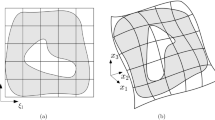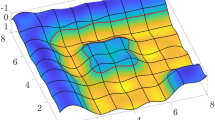Abstract
This paper proposes a method for simulating real-time haptic interaction with deformable objects. The deformable model consists of regular hexahedrons of a single type. This homogeneity is exploited to improve the efficiency in deformation computations. Model boundaries are approximated using a moving-least-squares function reflecting the deformation results of the hexahedrons. A method for adaptively approximating the model boundaries is presented for efficient collision handling in the haptic loop. The proposed method can simulate a model of 16,481 nodes in less than 1 ms, which is a significant improvement over the previous methods in the literature. Small gap between the model boundary and the hexahedrons can cause errors in the proposed method. Numerical examples considering the characteristics of human tissues show that the errors are less than just-noticeable difference of human.












Similar content being viewed by others
References
Zhang J, Zhong Y, Gu C (2018) Deformable models for surgical simulation: a survey. IEEE Rev Biomed Eng 11:143–164
Peterlik I, Nouicer M, Duriez C, Cotin S, Kheddar A (2011) Constraint-based haptic rendering of multirate compliant mechanisms. IEEE Trans Haptics 4(3):175–187
Tian Y, Yang Y, Guo X, Prabhakaran B (2014) Haptic simulation of needle-tissue interaction based on shape matching. In: Proceedings of IEEE international symposium on haptic, audio and visual environments and games (HAVE 2014), pp 7–12
Knott TC, Kuhlen TW (2016) Accurate and adaptive contact modeling for multi-rate multi-point haptic rendering of static and deformable environments. Comput Graph 57:68–80
Zhang X, Sun W, Song A (2014) Layered rhombus-chain-connected model for real-time haptic rendering. Artif Intell Rev 41(1):49–65
Wang D, Shi Y, Liu S, Zhang Y, Xiao J (2014) Haptic simulation of organ deformation and hybrid contacts in dental operations. IEEE Trans Haptics 7(1):48–60
Zhang J, Zhong Y, Gu C (2019) Neural network modelling of soft tissue deformation for surgical simulation. Artif Intell Med 97:61–70
Barbič J, James DL (2008) Six-dof haptic rendering of contact between geometrically complex reduced deformable models. IEEE Trans Haptics 1(1):39–52
Ryckelynck D, Chinesta F, Cueto E, Ammar A (2006) On the a priori model reduction: overview and recent developments. Arch Comput Methods Eng 13(1):91–128
Niroomandi S, Alfaro I, Cueto E, Chinesta F (2008) Real-time deformable models of non-linear tissues by model reduction techniques. Comput Methods Programs Biomed 91(3):223–231
Niroomandi S, Alfaro I, Cueto E, Chinesta F (2012) Accounting for large deformations in real-time simulations of soft tissues based on reduced-order models. Comput Methods Programs Biomed 105(1):1–12
González D, Alfaro I, Quesada C, Cueto E, Chinesta F (2015) Computational vademecums for the real-time simulation of haptic collision between nonlinear solids. Comput Methods Appl Mech Eng 283(1):210–223
Taylor ZA, Cheng M, Ourselin S (2008) High-speed nonlinear finite element analysis for surgical simulation using graphics processing units. IEEE Trans Med Imaging 27(5):650–663
Joldes GR, Wittek A, Miller K (2010) Real-time nonlinear finite element computations on GPU–Application to neurosurgical simulation. Comput Methods Appl Mech Eng 199:3305–3314
Mafi R, Sirouspour S, Mahdavikhah B, Moody B, Elizeh K, Kinsman A, Nicolici N (2010) A parallel computing platform for real-time haptic interaction with deformable bodies. IEEE Trans Haptics 3(3):211–223
Mahdavikhah B, Mafi R, Sirouspour S, Nicolici N (2014) A Multiple-FPGA parallel computing architecture for real-time simulation of soft-object deformation. ACM Trans Embed Comput Syst (TECS) 13(4):81
Courtecuisse H, Allard J, Kerfriden P, Bordas SP, Cotin S, Duriez C (2014) Real-time simulation of contact and cutting of heterogeneous soft-tissues. Med Image Anal 18(2):394–410
Jia S, Zhang W, Yu X, Pan Z (2015) CPU–GPU mixed implementation of virtual node method for real-time interactive cutting of deformable objects using OpenCL. Int J Comput Assist Radiol Surg 10(9):1477–1491
Jia S, Zhang W, Yu X, Pan Z (2018) CPU–GPU Parallel framework for real-time interactive cutting of adaptive octree-based deformable objects. Comput Graph Forum 37(1):45–59
Weber D, Bender J, Schnoes M, Stork A, Fellner D (2013) Efficient GPU data structures and methods to solve sparse linear systems in dynamics applications. In: Computer graphics forum, vol 32, no 1. Blackwell Publishing Ltd, Oxford
Kumar AV, Padmanabhan S, Burla R (2008) Implicit boundary method for finite element analysis using non-conforming mesh or grid. Int J Numer Meth Eng 74(9):1421–1447
Kumar AV, Burla R, Padmansbhan S, Gu L (2008) Finite element analysis using nonconforming mesh. J Comput Inf Sci Eng 8(3):031005
Dick C, Georgii J, Westermann R (2011) A hexahedral multigrid approach for simulating cuts in deformable objects. IEEE Trans Vis Comput Graph 17(11):1663–1675
Wu J, Dick C, Westermann R (2013) Efficient collision detection for composite finite element simulation of cuts in deformable bodies. Vis Comput 29(6–8):739–749
Müller M, Dorsey J, McMillan L, Jagnow R, Cutler B (2002) Stable real-time deformations. In: Proceedings of the 2002 ACM SIGGRAPH/eurographics symposium on computer animation, pp 49–54
Barnes JM, Przybyla L, Weaver VM (2017) Tissue mechanics regulate brain development, homeostasis and disease. J Cell Sci 130(1):71–82
Fierz B, Spillmann J, Harders M (2011) Element-wise mixed implicit-explicit integration for stable dynamic simulation of deformable objects. In: Proceedings of the 2011 ACM SIGGRAPH/eurographics symposium on computer animation, pp 257–266
Xie H, Liu H, Luo S, Seneviratne LD, Althoefer K (2013) Fiber optics tactile array probe for tissue palpation during minimally invasive surgery. In: 2013 IEEE/RSJ international conference on intelligent robots and systems, pp 2539–2544
Müller M, Heidelberger B, Teschner M, Gross M (2005) Meshless deformations based on shape matching. ACM Trans Graph (TOG) 24(3):471–478
Fried I (1972) Condition of finite element matrices generated from nonuniform meshes. AIAA J 10(2):219–221
Lim YJ, Deo D, Singh TP, Jones DB, De S (2009) In situ measurement and modeling of biomechanical response of human cadaveric soft tissues for physics-based surgical simulation. Surg Endosc 23(6):1298–1307
Anuradha C, Ramakrishna B, Venkatramani S (2012) Formula for calculating standard liver volume in Indians. Indian J Gastroenterol 31(1):15–19
Atluri SN, Cho JY, Kim HG (1999) Analysis of thin beams, using the meshless local Petrov–Galerkin method, with generalized moving least squares interpolations. Comput Mech 24(5):334–347
Lancaster P, Salkauskas K (1981) Surfaces generated by moving least squares methods. Math Comput 37(155):141–158
De S, Bathe KJ (2001) Displacement/pressure mixed interpolation in the method of finite spheres. Int J Numer Meth Eng 51(3):275–292
Steven WS (1997) The scientist and engineer’s guide to digital signal processing. California Technical Pub
The Stanford 3D Scanning Repository. http://graphics.stanford.edu/data/3Dscanrep/
Paggetti G, Cizmeci B, Dillioglugil C, Steinbach E (2014) On the discrimination of stiffness during pressing and pinching of virtual spring. In: 2014 IEEE international symposium on haptic, audio and visual environments and games (HAVE) proceedings, pp 94–99
Acknowledgements
This work was supported by the National Research Foundation of Korea (NRF) Grants funded by the Ministry of Science and ICT (Nos. NRF-2015R1A2A1A10054420, and NRF-2019R1H1A2080008) and the Brain Korea 21 PLUS Program.
Author information
Authors and Affiliations
Corresponding author
Additional information
Publisher's Note
Springer Nature remains neutral with regard to jurisdictional claims in published maps and institutional affiliations.
Rights and permissions
About this article
Cite this article
Byeon, S.P., Lee, D.Y. Method for real-time simulation of haptic interaction with deformable objects using GPU-based parallel computing and homogeneous hexahedral elements. Comput Mech 65, 1205–1218 (2020). https://doi.org/10.1007/s00466-020-01815-3
Received:
Accepted:
Published:
Issue Date:
DOI: https://doi.org/10.1007/s00466-020-01815-3




